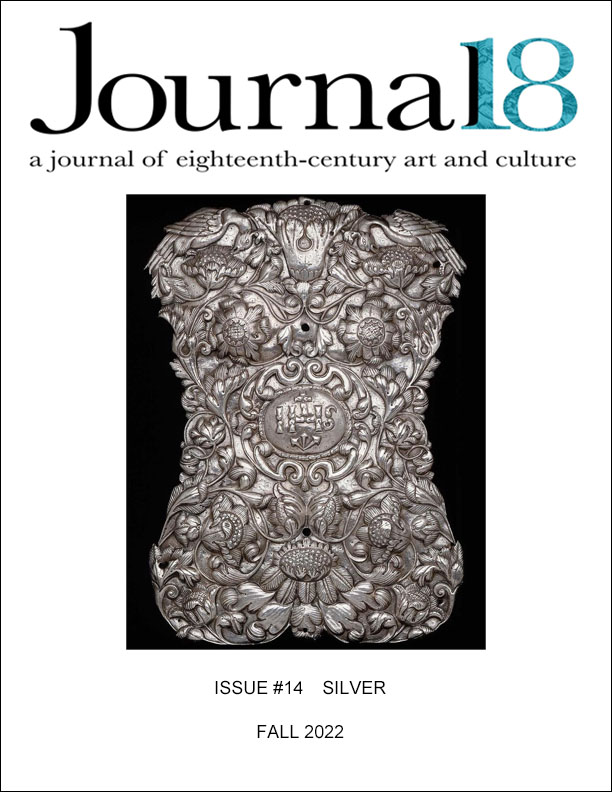
In his 1656 treatise El Paraíso en el Nuevo Mundo, Antonio de León Pinelo contends that the amount of silver extracted from Potosí’s Cerro Rico was enough to build a bridge of silver from the top of the mountain to the doors of Madrid’s Royal Palace: 2,070 leagues long, 14 rods wide, and 4 fingers thick.[1] The vivid imagery of León Pinelo’s account encapsulates the magnitude of silver’s potential as the material foundation for a fantastical building project that could physically scale the earth much like the Spanish Empire did politically, militarily, and financially. Silver’s beauty, mutability, and strength coveted by Spanish colonists led to the production of spectacular objects, such as the ornamental plaque from a Jesuit Mission in the Andean highlands that serves as this issue’s cover image. At once luxurious and symbolic, the plaque’s decoration features tulips and other plants cultivated in Europe, interwoven in a repouséd floral ground with indigenous passion flowers (mburucuyà), nibbled by native birds, to create an image of a harmonious colonial society. Both the imaginary bridge and the ornamental plaque belie the violence the Spanish Crown and the Church exerted in subjugating native populations and instituting a system of forced labor to extract this precious metal.
Within and beyond the Spanish Empire, silver financed wars, upheld dynasties, and cemented political alliances. Forged into currency, silver funded slavery and the institution’s production of goods such as sugar and cacao. Silver was also valued around the globe for its pliability and sheen. From Beijing to Versailles, Mexico City to Lisbon, it furnished grand homes, glittering on dinner tables and dressing tables alike. Skilled artists manipulated silver into opulent objects, capitalizing on its luster to fabricate sinuous forms in small-scale decorative artworks as well as ambitious commissions that communicated wealth and political might.
This issue probes silver’s capacity for metamorphosis—from raw material into objects and currency. Such transformative characteristics made it a valuable medium for artists, a tool for global expansion, and a form of income for rebuilding state treasuries. The articles, while specific in their discussion and context, suggest insightful cross-fertilizations. Dani Ezor analyzes Henriette Julie Gabrielle de Lorraine, duchess of Cadaval’s lavish toilette set in order to interrogate connections among race, gender, familial duty, colonialism, and silver’s “polish.” Christina Lindeman centers her discussion of silver within Frederick II’s Prussian court, arguing that the use of silver thread in both court gowns and military uniforms were key to his political, artistic, and economic machinations. Focusing on a single object, Susan Eberhard addresses the global significance of a Chinese ewer gifted to the Siamese king and then appropriated into the French court as a Japanese chocolatière for serving hot chocolate, a Mesoamerican custom fashionable in Europe.
In a selection of shorter essays, entitled “Explorations,” James Middleton looks at a portrait miniature painted on a silver ground, an incredibly rare use of this metal, as a product of Mexico’s silver boom in the later eighteenth century. José Andrés De Leo Martínez considers the standardization of the Chalice’s design in Puebla as a product of international exchange and regional identity. As a practicing silversmith and art historian, Christina Clarke evaluates the techniques, materials, and tools of artisans who forged Louis XIV’s opulent silver collection by using probate inventories and technical processes to uncover lost methods of artisanal silver production.
By situating silver within multivalent contexts of colonialism, trade, diplomacy, religion, and art, it is our hope that these (re)considerations of silver’s vital roles in the early modern period contribute new understandings to this prized material and its significance in building larger networks and systems of power.
Issue Editors
Agnieszka Ficek, CUNY Graduate Center
Tara Zanardi, Hunter College
ARTICLES
“White when Polished:” Race, Gender, and the Materiality of Silver at the Toilette
Dani Ezor
Silver Thread Textiles: Industry, Dynasty, and Political Power in Eighteenth-Century Prussia
Christina Lindeman
The Asian Silver Chocolatière: The Transpacific World in a Diplomatic Gift
Susan Eberhard
EXPLORATIONS
An Eighteenth-Century Portrait Miniature on Silver: An Artifact from the Silver Age of Mexico
James Middleton
La distinción del cáliz de Puebla de los Ángeles en el s. XVIII, entre dos Mundos
José Andrés De Leo Martínez
Reanimating the Goldsmith: An Artisanal Reading of the Archive
Christina Clarke
Cover image: Ornamental Plaque (mariola or maya), one of a pair, 1725-50. Moxos or Chiquitos missions, Alto Peru (present-day Bolivia). Silver, 42 × 31 × 3 cm. Museum of Fine Arts Boston, Gift of Landon T. Clay, 1992.346. Image source: https://collections.mfa.org/objects/42400.
[1] Antonio de León Pinelo, El Paraiso en el Nuevo Mundo: comentario apologetico (Madrid, 1656), quoted in Guillermo Francovich, Los Mitos Profundos de Bolivia (La Paz: Editorial Los Amigos del Libro, 1980), 79-80.
